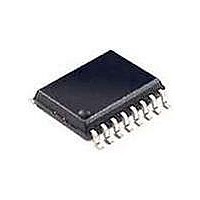SI2400-BSR Silicon Laboratories Inc, SI2400-BSR Datasheet - Page 18

SI2400-BSR
Manufacturer Part Number
SI2400-BSR
Description
Telecom Line Management ICs CONTACT SILICON LABS FOR AVAILABILITY
Manufacturer
Silicon Laboratories Inc
Type
Integrated Global DAAr
Datasheet
1.SI2400-BS.pdf
(94 pages)
Specifications of SI2400-BSR
Product
Modem Chip
Supply Voltage (min)
3 V
Supply Current
21 mA
Maximum Operating Temperature
+ 85 C
Minimum Operating Temperature
- 40 C
Mounting Style
SMD/SMT
Package / Case
SOIC-16
Lead Free Status / RoHS Status
Lead free / RoHS Compliant
Si2400
5.5. Parallel Phone Detection
The Si2400 has the ability to detect a phone or other
device that is off hook on a shared line. This enables the
ISOmodem to avoid interrupting a call in progress on a
shared line and to intelligently handle an interruption by
another device when the Si2400 is using the line. An
automatic algorithm to detect parallel phone intrusion
(defined as an off-hook parallel handset) is provided by
default.
5.5.1. On-Hook Intrusion Detection
To implement intrusion detection, the Si2400 uses loop
voltage sense register SDB (LVCS). When on hook,
LVCS monitors the line voltage. (When off-hook, it
measures line current.) LVCS has a full scale of 87 V
with an LSB of 2.75 V. The first code (0 → 1) is skewed
such that a 0 indicates that the line voltage is < 3.0 V.
The voltage accuracy of LVCS is ±20%. The user can
read these bits directly when on hook through register
SDB (LVCS).
The automatic on-hook detector algorithm can be
tripped by either an absolute level or by a voltage
differential
absolute or S13[3] (ONHD) = 1
18
by
selecting
LVC S
BITS
30
25
20
15
10
5
0
0 3 6
Figure 7. Loop Voltage—LVCS Transfer Function
S13[3] (ONHD) = 0
b
9 12 15 18 21 24 28 30 33 36 39 42 45 47 51 54 57 60 63 66 69 72
for differential. If the
b
for
Rev. 1.3
Loop Voltage (V)
absolute detector is chosen, the Si2400 algorithm will
detect an intrusion if LVCS is less than the value stored
in on-hook intrusion threshold, S11[4:0] (AVL). In other
words, an intrusion has occurred if LVCS < AVL.
AVL defaults to 1000
absolute detector is the correct method to use for most
countries and should also be used to detect the
presence (or absence) of a line connection.
Under the condition of a very short line and a current-
limiting telephone off hook, the off-hook line voltage can
be as high as 40 V. The minimum on-hook voltage may
not be much greater. This condition can occur on phone
lines with current-limiting specifications such as France.
For these lines, a differential detector is more
appropriate.
The differential detector method checks line status
every 26.66 ms. The detector compares (LVCS (t –
set in register S11[7:5] (DVL). The default for DVL is
0x02 (5.5 V). If the threshold is exceeded (LVCS (t –
(LVCS (t) – LVCS (t – 0.02666) > DVL), then the
intrusion is said to have terminated.
0.02666) – LVCS (t)) to the differential threshold level
0.02666) – LVCS (t) > DVL), an intrusion is detected. If
75 78 81 84 87
b
, or 25 V on powerup. The
100












